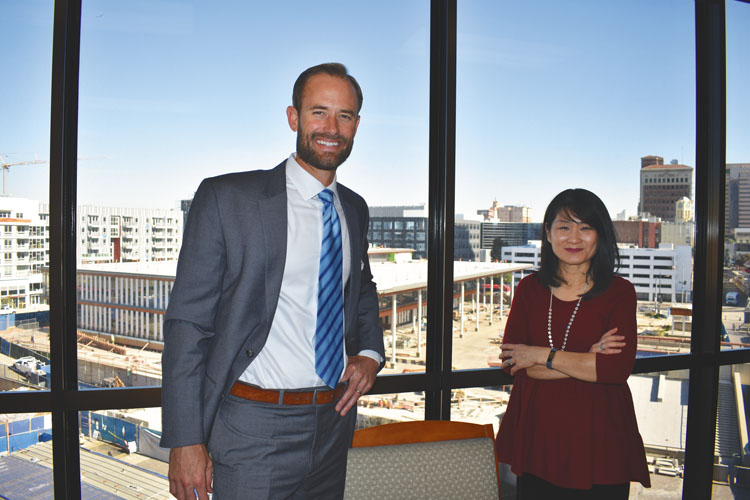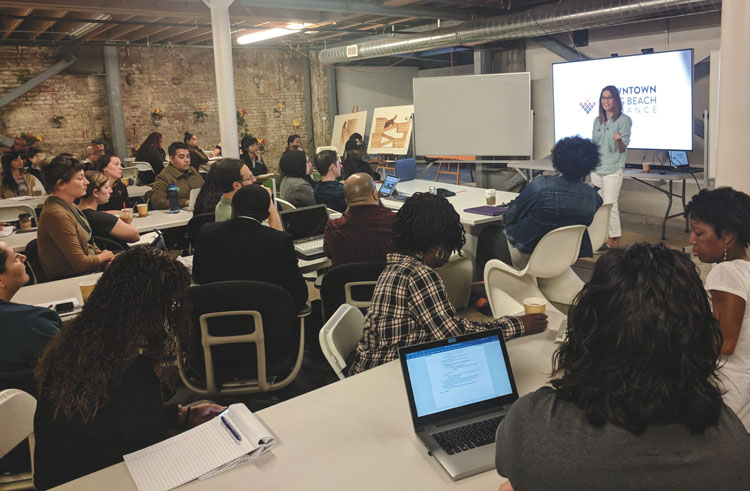For entrepreneurs looking to set up shop or invest in Downtown Long Beach, there are a number of assistance programs at their disposal. This includes city resources, as well as those provided by the nonprofit Downtown Long Beach Alliance (DLBA) and the Small Business Development Center (SBDC) hosted by Long Beach City College.
On the municipal side, many programs now available to businesses and investors are a result of the Long Beach Economic Development Blueprint adopted in 2017. The blueprint outlines a 10-year strategy to engage and enhance Long Beach’s commercial ecosystem. John Keisler, director of economic and property development for the city, summed up his department’s mission like so: “Really, our job is to help people make more money.”

Established in collaboration with city staff and the Long Beach Economic Development Commission, the blueprint identifies three types of earners: workers, business owners and investors. Goals are set by the city for each of these earner types:
- for workers, providing “more fulfilling, higher-wage job opportunities”;
- for investors, creating a “can do” economic climate that fosters healthy competition;
- for entrepreneurs, cultivating “an innovative ecosystem that lays a foundation for success from business start up to growth.”
Keisler told the Business Journal that the city has since designed a number of programs to fulfill these goals. “No matter how you make your money, you can come to Long Beach and you can do it,” he said.
In January, the City of Long Beach launched the Kiva program, a microfinancing resource for entrepreneurs without access to traditional loans. With 0% interest and no fees, Kiva enables business owners to obtain small loans from a crowdfunding platform that are then matched dollar-for-dollar by the city. “This is for the person who does not necessarily have good credit [but] may not need a whole lot of money,” Seyed Jalali, economic development officer for the city, explained.
Kiva Long Beach is a public-private partnership between the city, national non-profit Local Initiatives Support Corporation, and 13 different organizations in Long Beach that act as the program’s trustees. Jalali said that Kiva allowed the city to fill a gap in its existing micro-loan program, which did not extend to loans below $25,000. “We were never able to catch those individuals who really didn’t need that much, or could afford that much,” Jalali said. “So $5,000 or $2,500 to buy a hot dog cart, how do you address that?”
For larger investors, the city is introducing a new tool for 2019: federal Opportunity Zones. These zones are defined as economically-distressed communities where new investments, under certain conditions, are eligible for preferential tax treatment. Created by the Tax Cuts and Jobs Act of 2017, 19 such zones (identified by census tract) exist in the City of Long Beach – some of which overlap the downtown area. “It offers tax breaks to investors who revitalize in certain urban areas and along major business corridors,” Becky Blair, president and principal of Coldwell Banker Commercial BLAIR WESTMAC, explained. “It’s a very complex program, but experienced developers and investors will be interested.”
Through this program, capital may be invested in opportunity funds dedicated to improving these distressed areas. After five years, the tax rate for capital gains on these funds is reduced by 10%. After 10 years, 100% of capital gains are forgiven on the property, Keisler said. “It’s a major opportunity for real estate investment in the coming year.”
Another useful tool for both businesses and residents is the city’s Economic Insights Dashboard (dashboards.mysidewalk.com), an interactive resource for analyzing key metrics in the city. The online resource allows users to research current statistics on population, economy, housing, transportation and health. The information is synced with national databases that are updated automatically, Keisler said, so it will always be as up-to-date as possible. The dashboard is a means of measuring the success of city’s blueprint, he went on, and also functions as DIY consumer market research for investors and developers.
Like Kiva, StartitUp is a public-private partnership designed to get new businesses on their feet. Long Beach was the first city in the United States to offer this mobile app, both a “pocket coach” and roadmap to help new entrepreneurs build a sustainable business plan, obtain financing and avoid common pitfalls. “StartitUp is an incredible story of how we’re leveraging technology to help entrepreneurs get the support they need in an efficient way,” Keisler said.
The app was developed in partnership with Long Beach’s Small Business Development Center (SBDC), which is hosted by Long Beach City College (LBCC). Sheneui Weber, chief operating officer for LBCC’s College Advancement and Economic Development program, said that SBDC was interested in finding a way to help new businesses off the clock. “Everything we do is face to face,” Weber explained of the SBDC, which provides daily workshops and business advising to hopeful entrepreneurs. “The problem is, we’re only here eight hours a day. Entrepreneurs don’t sleep.”
What most attracted SBDC to the app, Weber said, was its interest in reducing the failure rate of new businesses. With 24/7 access to the most up-to-date information on business development and bite-sized tutorials to prepare entrepreneurs for each step of the process, the app received SBDC’s approval. Perhaps most essential, Weber continued, is the app’s mentoring feature. “There’s a lot of information about how to start your business out there, but there’s so much noise,” Weber said. “Research has shown that if you have a mentor you’re a lot more successful.” The interactive app puts users in touch with their own advisor to assess their strengths and weaknesses and help them to improve. Weber said the app garnered positive feedback from entrepreneurs who tried it during its pilot phase.
SBDC also manages the Goldman Sachs 10,000 Small Businesses Plan. “It’s kind of like a mini-MBA for small businesses,” Weber explained. “It’s an intensive four-month executive management program.” SBDC has graduated 21 cohorts, or classes, in the Long Beach area alone, and tracks the success of its alumni. “What we’ve seen is that, compared to the national average of small business job creation and revenue growth, the Goldman Sachs scholars or alumni increase their revenues and create jobs within six months of completing the program.”
Weber said LBCC views the Small Business Development Center as an integral extension of its curriculum. “It’s about job creation,” she explained. “Economic development is one of the three primary missions of the California Community Colleges [System].” LBCC’s leadership wants to produce students who are either moving into the workforce or moving on to advanced degrees and then entering the workforce, Weber said. “If we don’t focus on job creation in our communities, we can educate all day and then our students have no jobs to go into. It’s all about retaining local talent, keeping the jobs here, helping local businesses grow. It’s the circle of life.”
By Weber’s count, the Long Beach SBDC helped secure about $14 million in loan funding for small businesses last year, while also creating about 193 jobs and 36 businesses. Those figures have increased in 2018. As of September 30 (the most recent figures available), SBDC has secured $22 million in capital, created about 340 jobs and helped start 43 businesses.

The nonprofit Downtown Long Beach Alliance (DLBA) manages the overlapping property and parking improvement districts that are located in the downtown area. The parking district charges an assessment fee on businesses while the property district assesses commercial and residential property owners. These fees are used to fund city beautification, economic development and marketing, explained DLBA Economic Development and Policy Manager Austin Metoyer. “So, trying to make downtown an attractive place to do business, an attractive place for people to come to and hang out, shop, eat and so forth,” he said.
When a new business joins the district, Metoyer explained, the DLBA may assist with promoting its grand opening. That includes social media coverage, connecting the business owner to neighborhood associations, city officials and the mayor’s office, and helping with press release materials. “For us, it’s about trying to get each business on the right foot, and the successful foot, at the beginning,” Metoyer said. That means building a community that embraces new businesses and, in turn, putting a spotlight on new businesses for the community.
The DLBA also hosts workshops and training seminars throughout the year. One such program is the Entrepreneur and Small Business Education Series, a partnership between the DLBA and California State University, Long Beach. This free, seven-week course is focused on providing entrepreneurs with the tools they need to take their business from idea to implementation, and includes instruction on accounting basics, HR practices, funding opportunities, digital marketing, employee hiring, industry-specific site selection and much more. “It’s kind of a 101 business training,” Metoyer said.

The DLBA also hosts 1 Million Cups, a monthly gathering to help startups pitch their ideas to investors and other entrepreneurs in the community. Founded by the Kauffman Foundation, the gathering takes its name from the idea of connecting entrepreneurs over a million cups of coffee nationwide. “That has created a network of startups [downtown], which is really cool,” Keisler said.
Despite offering multiple services in education and assistance, Metoyer said, the DLBA’s biggest challenge is making contact with every business in its purview. “As [much as] humanly possible you could try to reach everyone, but you still won’t be able to,” Metoyer said. “Just trying to get the word out about what we do, who we are and getting it across to everybody, across all mediums and platforms, that’s still an ongoing challenge.”
Metoyer said that, of the more than 1,600 businesses located downtown, the DLBA’s staff of 10 regularly interacts with perhaps 30% of them. That’s partially because many businesses are located in office towers like World Trade Center and Landmark Square rather than at the ground level, Metoyer said, but he’d like to see the interaction grow. The best way to do that, he went on, is to just “drop in.” That means stopping by or calling the office at 100 W. Broadway, or messaging them on social media or online. However the DLBA is able to get in contact with its businesses, he said, the team is happy to reach out.
